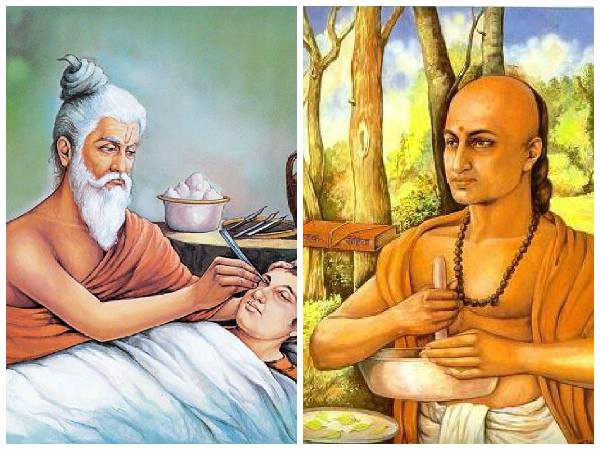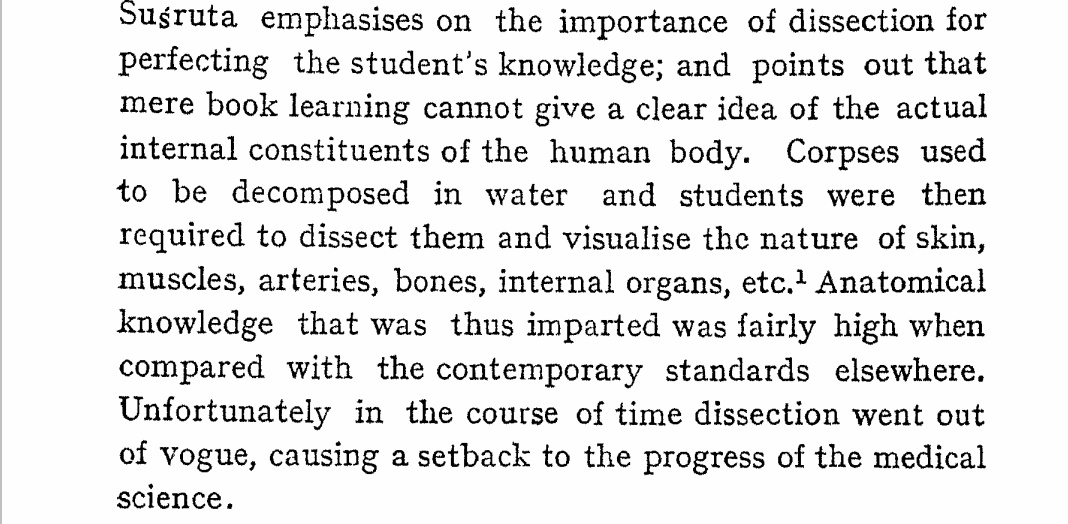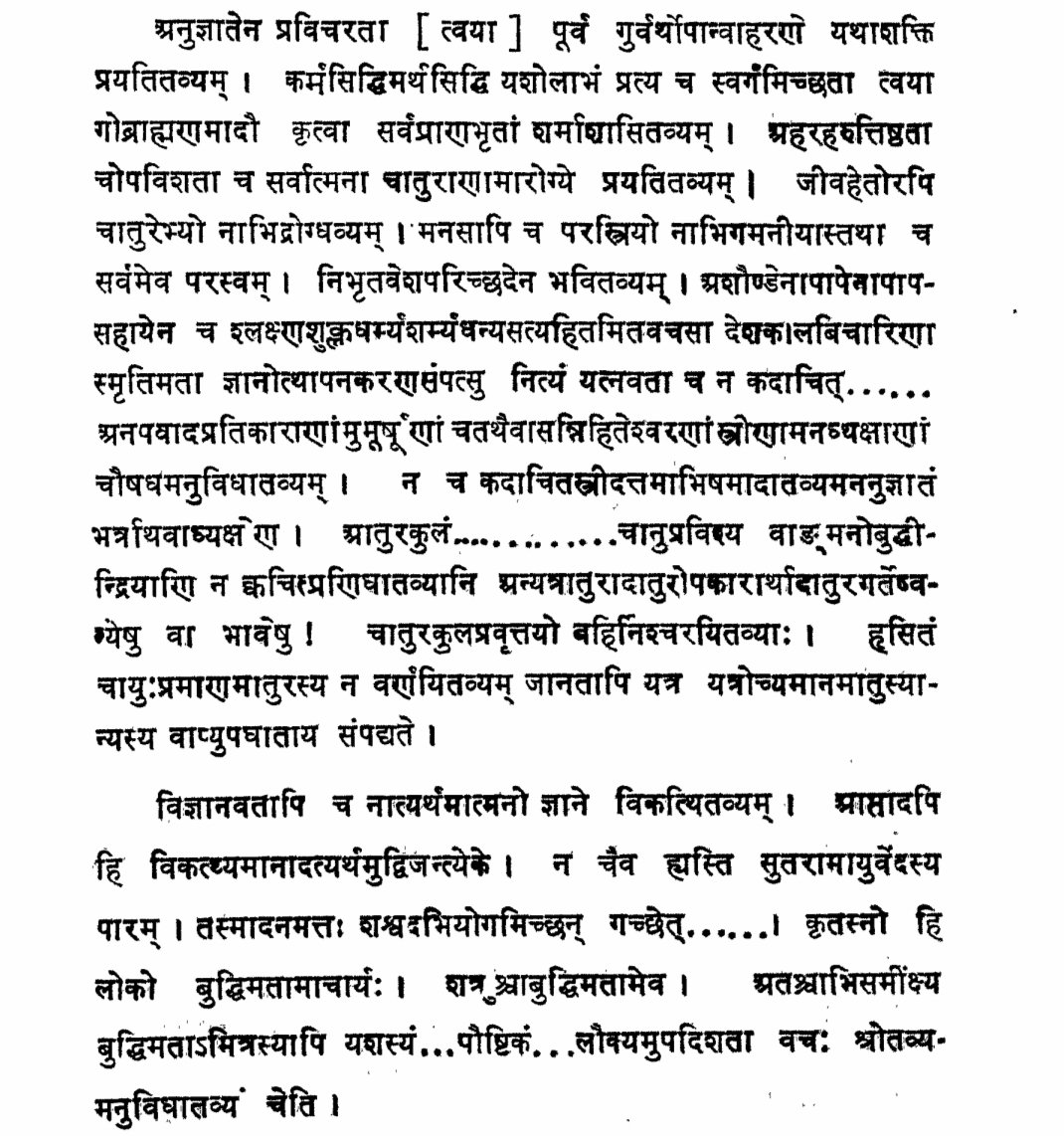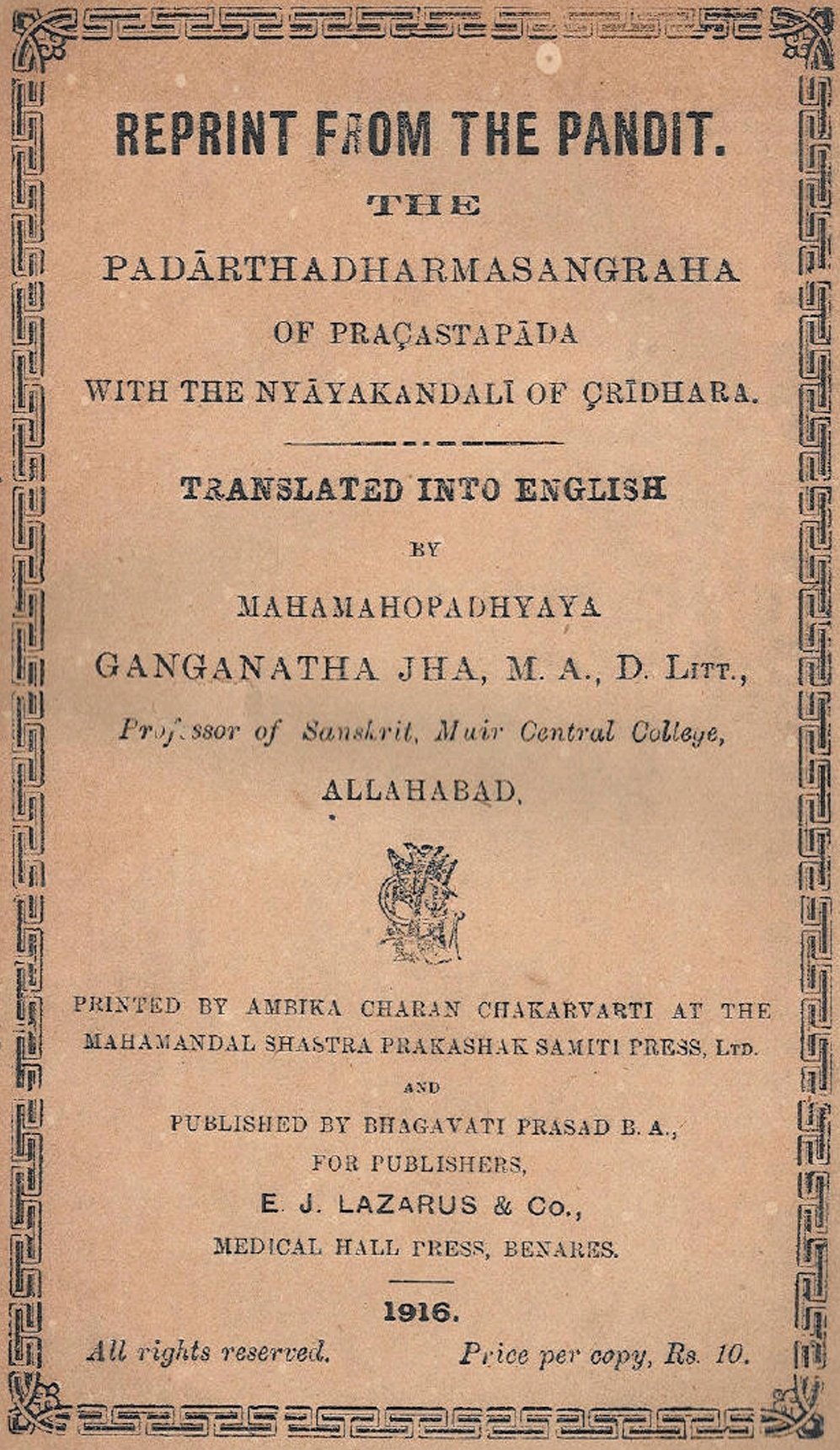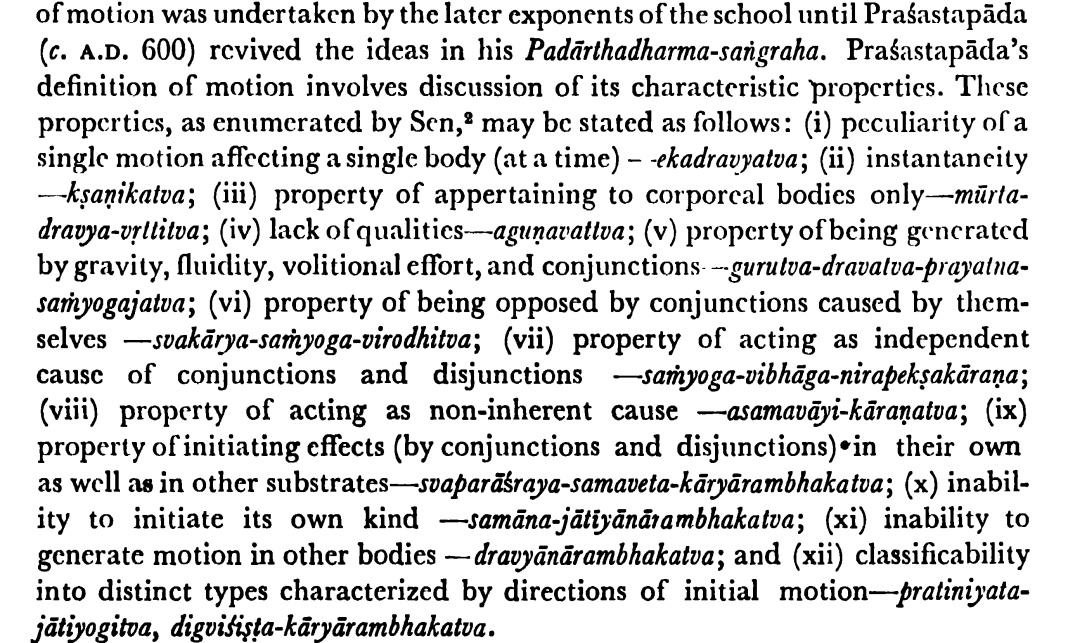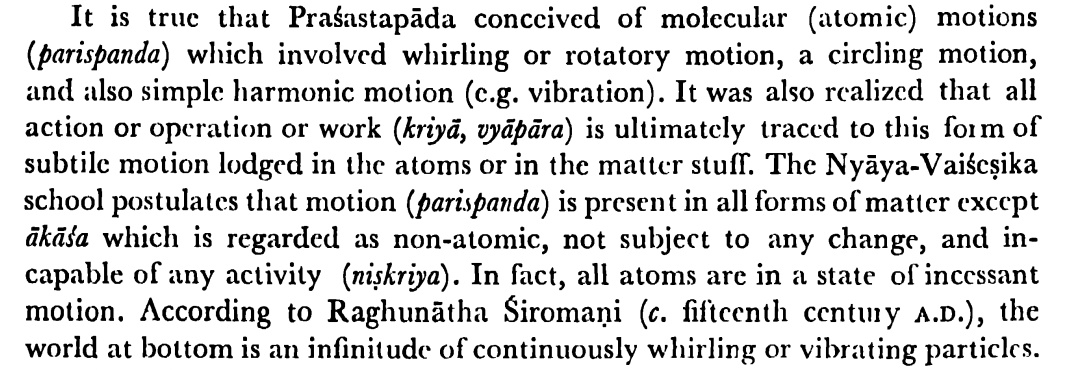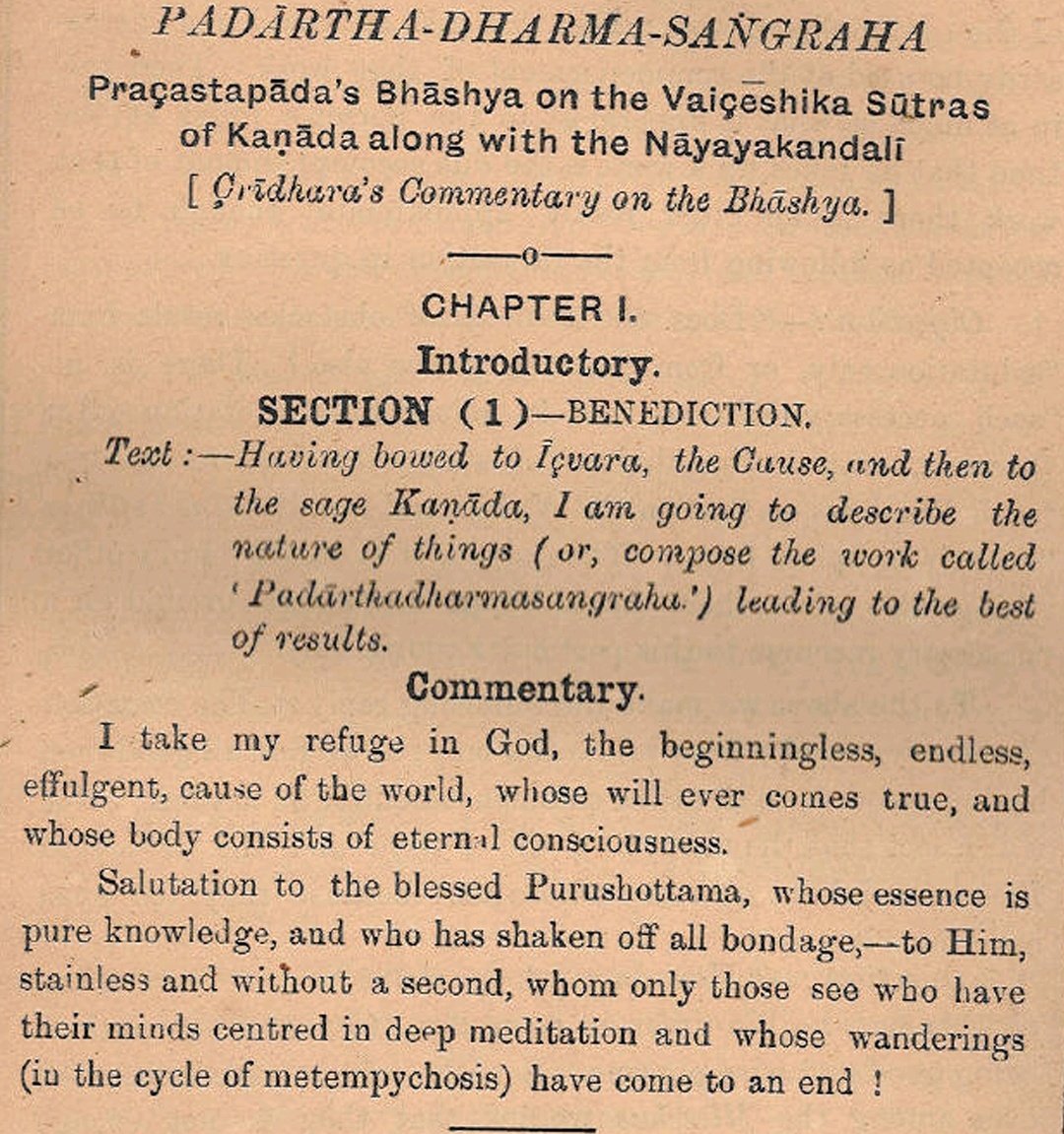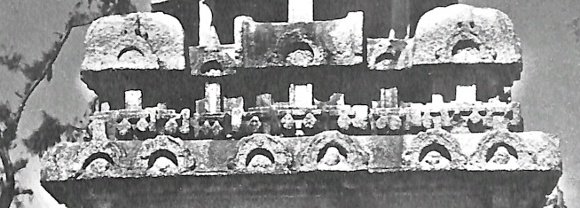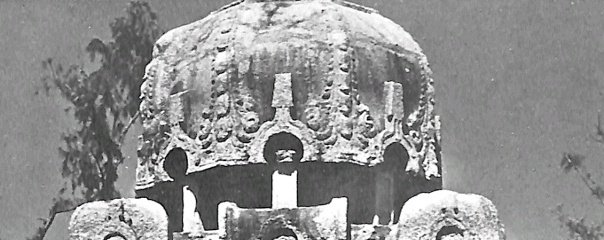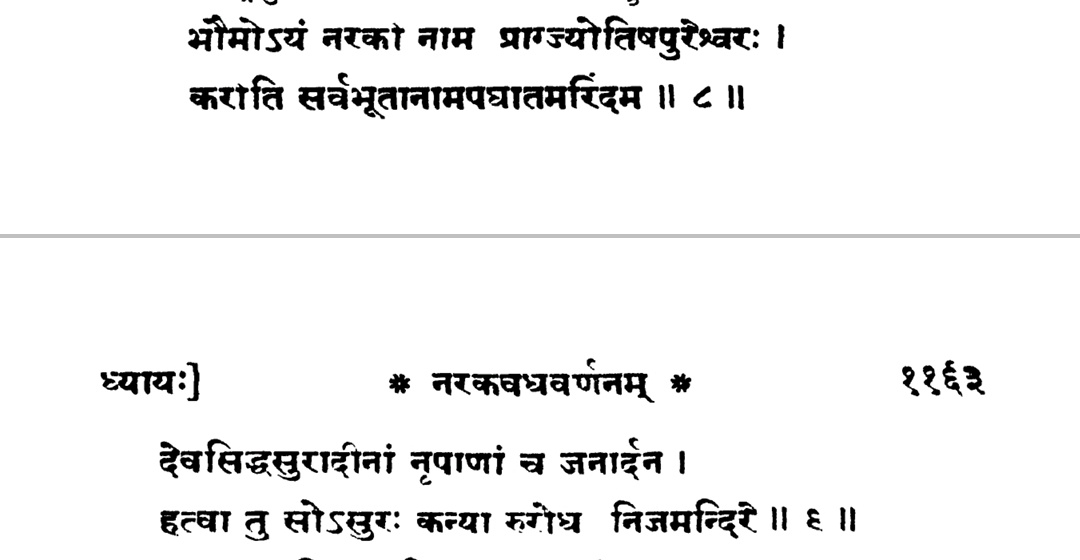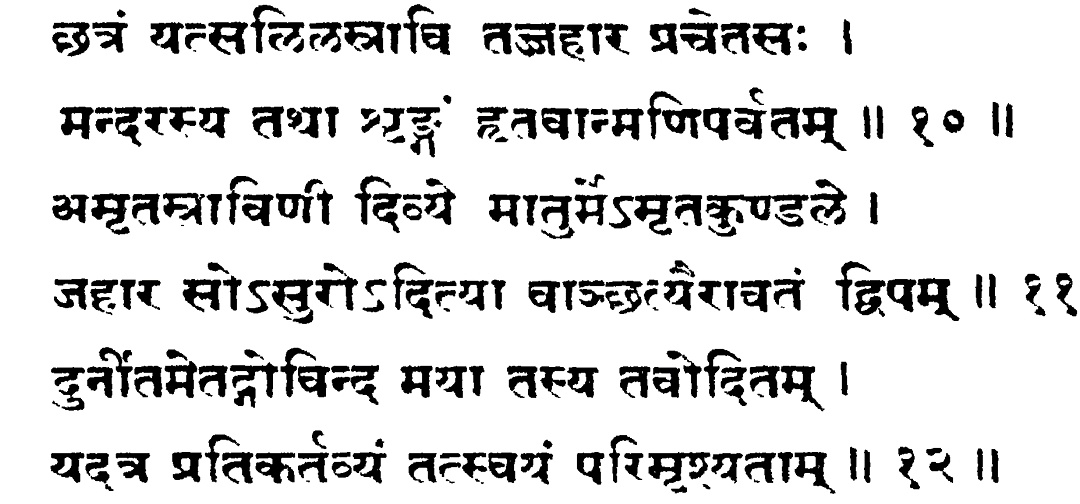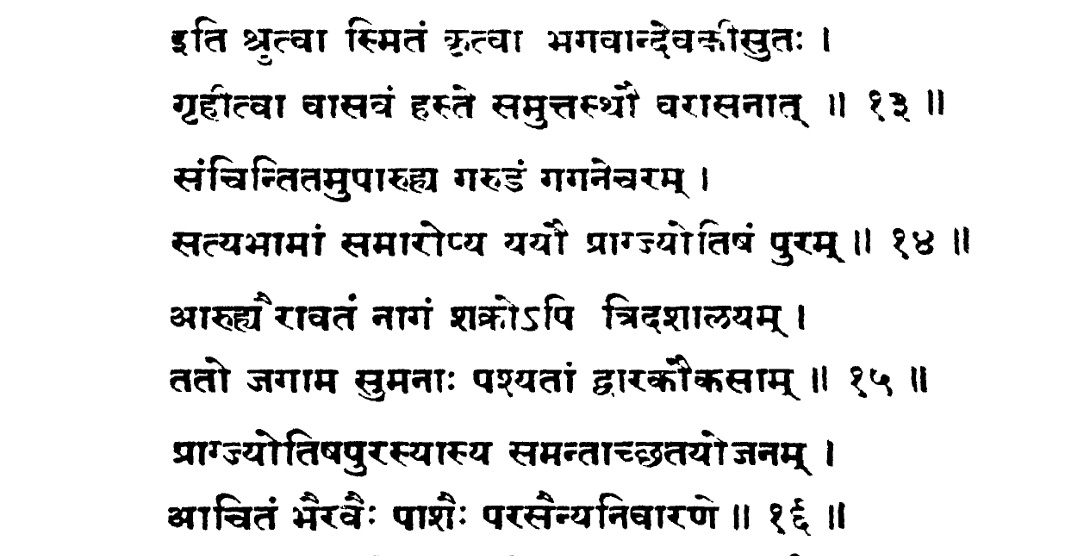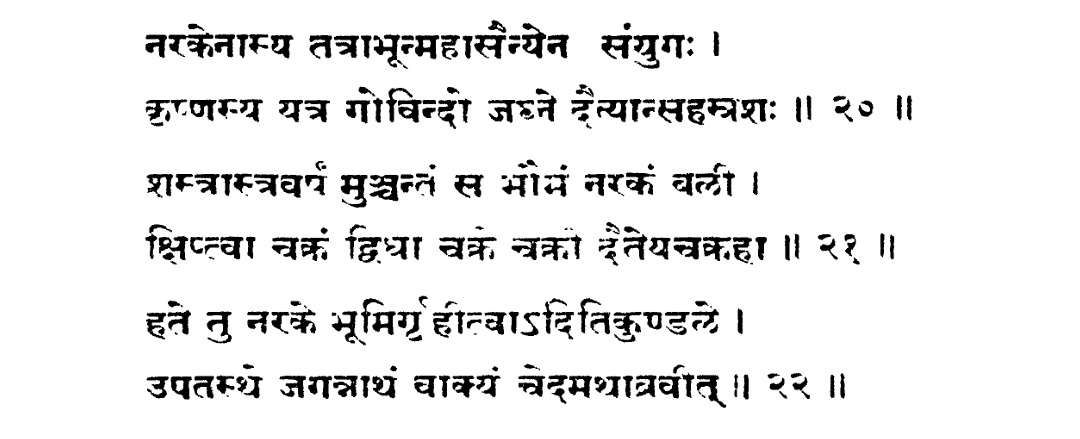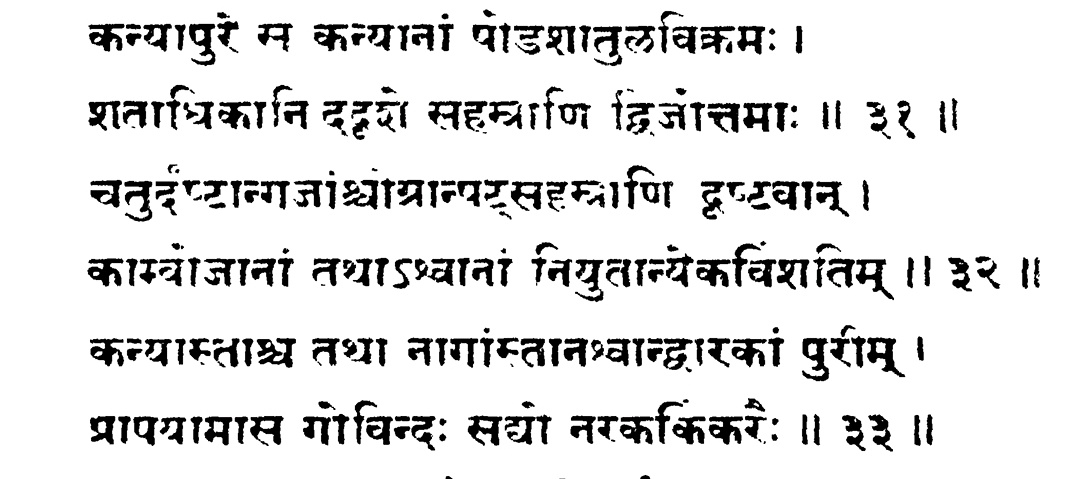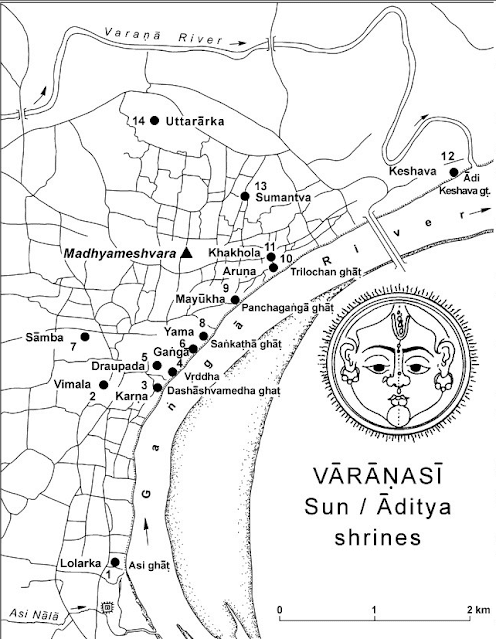 |
| The 14 Surya Temples of Kashi as mapped out by Prof Rana P.B. Singh |
Surya Temples mentioned in the map are no ordinary teerthas. They find mention in the Skandapuranam.The sthalapurana of each one of these temples is explained in detail by Skanda to Agastya muni. Its worth having a look at the puranic description of each of these teerthas. The Shlokas below from the Skandapuranam making a mention of each Temple.
1) LOLARKADITYA TEERTHA
Lolarka is considered to be the foremost among of Surya teerthas at Kashi. It came to be known by that name since Surya was very eager to see Kashi when he came down to test the then ruler of Kashi, Divodasa. Its exact location is given in the below shloka.
Lolarka was established in the southern direction of Kashi at the confluence of Asi river & Ganga. Skanda also mentions a number of benefits to be had by having a Darshana of Lolarka. A darshana of Lolarka on Rathasaptami removes all paapa.

Lolarka was once a grand & magnificient Temple, that is before the brutal islamic invasions. Today it is a very modest Temple that houses a small murthi of Suryanarayana. The Temple also has a Pushkarni(Tank) attached to it. It is called Lolark kund.
 |
| Lolarkaditya |

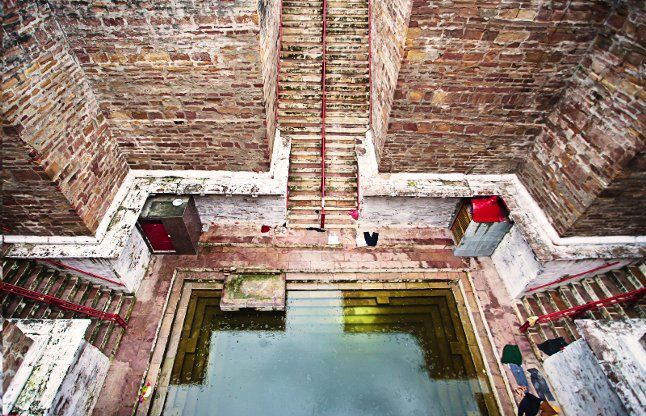 |
| Lolarka Kunda |
2) UTTARKADITYA TEERTHA
Uttararka is the next important teertha. The Sthalapurana of this teertha is that of an orphaned girl named Sulakshana who was left devastated by the untimely death of her parents.
The kindhearted Sulakshana to overcome her sorrow sits on a penance at Uttararka. During her penance she used to observe a goat kid which used to come there everyday & stand still in front of her. In the evening it used to eat grass & leaves & drink the water from the pool.
The same goat kid visited her everyday for many years during her penance. Eventually pleased with Sulakshana's devotion, Shiva & Parvathi grant her a darshan & ask her to choose a boon.
The kind & largehearted Sulakshana before asking for the boon thought to herself that the goat kid, which had been visiting her everyday for many years was equally deserving as her to be blessed, that since it being an animal didn't have a mouth to ask for anything.
Sulakshana requests that the goat kid be blessed instead. Shiva & Parvathi are left even more pleased by Sulakshana's conduct & kind nature. Eventually Sulakshana's becomes one of the companion of Parvathi along with Jaya,Vijaya, Jayantika, Subha & others & goes to Kailasa.
The goat kid meanwhile is blessed by Lord Shiva to be born as the princess of Kashi in its next birth. The teertha has also since then came to be known as "Barkari" Kunda. Below shloka says annual pilgrimage of Uttararka should be performed on a Sunday in the month of Pushya.
Uttarkaditya today is an extremely modest shrine housed within the precincts of a wall. Only can only image what a magnificent Temple this would have been before the invasions.
 |
Uttarkaditya
|
3) SAMBHADITYA TEERTHA
The next great Surya teertha is Sambaditya. Sambha, the son of Bhagavan Krishna, after being cursed by his father to suffer from leprosy when the he intrudes unannounced into Krishna's private residence. Krishna then advises Sambha to go to Kashi to rid of the curse.
On the advise of his father, Sambha reaches Kashi & performs severe austerities to please Surya. As a result he is cured of his condition (leprosy) Ever since, Sambaditya has become dispeller of all diseases. Anyone taking a dip at the kunda here is free from all ailments.
 |
| Sambhaditya |
4) DRUPADADITYA TEERTHA
The 4th great Surya Teertha is Draupadaditya. It is here that the Pandavas receive the Akshayapatra from Bhagavan Suryanarayana. Draupathi performs severe vratas at this very spot to attain it. The original temple has since been destroyed. The present structure is a very modest one.
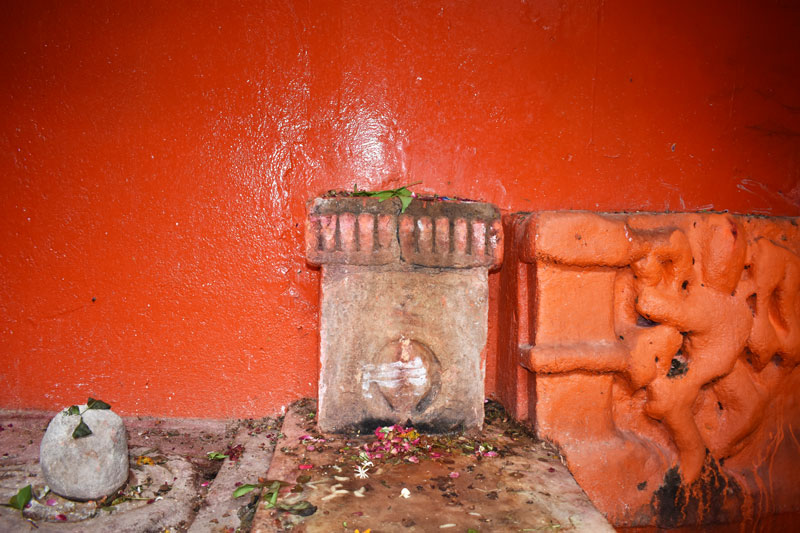 |
| Drupadaditya |
5) MAYUKADITYA TEERTHA
The 5th great Surya teertha is Mayukhaditya. This is where Lord Shiva grants Surya a number of Varas. The Mangalashtakam(recited at marriages) was composed by Lord Surya in praise of Gowri at this very spot. The present day Mayukhaditya shrine is inside the Mangala devi temple.
 |
| Mayukaditya |
6) KHAKHOLADITYA TEERTHA
The 6th great Surya teertha is Khakholkaditya. This teertha is closely associated with the story of Kadru & Vinata, mother of Nagas & Garuda. Its where Kadru tricks Vinata into thinking the color of Surya's horse, Uchchaihshravas was not pure white in colour.
Kadru instructs her snake children to camouflage Surya's horse (especially its tail) in order to make it look discoloured. Thus Vinata loses the bet & is forced to serve under Kadru as a slave. (This is very popular story told to many of us during childhood)
Why Vinata was destined to serve as a slave under kadru? We'll see later during the description of the next Surya Temple, i.e. Arunaditya. Vinata in order to rid of her paapa performs penance to Surya, who grants her the boon to destroy all paapa.
Khakholkaditya also came to be known as Vinataditya. The below sholkas mention that merely by the sight of Vinataditya, they are freed from all paapa. That one attains whatever they think of. They also instantaneously become free from any illness.
 |
| Khakholaditya |
7) ARUNADITYA TEERTHA
The 7th great Surya teertha is Arunaditya. The sthalapurana of this teertha again relates to Vinata. Eager to have a son, she breaks open her egg prematurely (800 yrs instead of a 1000). Thus was born a child who was incompletely developed from thighs downwards.
The underdeveloped child with a bright red face(Aruna) curses his mother for her hasty action of prematurely breaking open the egg & leaving him crippled.. He curses that Vinata in the future will be forced to serve as a slave under Kadru & her children.
Worried & wanting to perform Prayaschitta for her actions, Vinata asks Aruna what to do next. Aruna instructs her not to break open the next egg prematurely. That the one born from that egg will free her from enslavement. (Garuda frees his mother from enslavement eventually)
Aruna was also known by the name of Anuru because he had no thighs. He was known as Aruna because his face had become red due to anger. He went to Kashi to perform severe austerities to Surya who blessed Aruna & made him his charioteer. This is the story of Arunaditya.
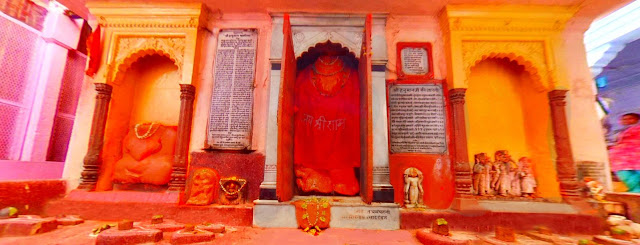 |
| Arunaditya |
 |
A closer view of Arunaditya |
8) VRIDDHADITYA TEERTHA
The 8th great Surya teertha is Vrddhaditya. The temple is located to the south of Kashi Vishalakshi temple. There once was a old Rishi by the name Harita who was deeply into performing penance. As a result of old age, it was increasingly becoming difficult for him to do so
In order to perform penance properly, Rishi Harita requests Surya to grant him back his youth. Surya obliges. The rishi is happy & performs a fierce penance again. Since then this teertha came to be known as Vrddhaditya, who is the destroyer of old age, misery & ailments.
 |
| Vriddhaditya |
 |
| Remnants of the original Vriddhaditya Temple |
9) KESHAVADITYA TEERTHA
The next great Surya teertha is Keshavaditya. Once Adi Keshava Vishnu was seen by Surya worshiping a Shiva-linga. On inquiry by Surya, Vishnu explains the significance of Shiva worship at Kashi. In a series of shlokas, Keshava praises Shiva to the hilt.
On hearing Vishnu's words, Surya creates a Spatika (crystal) linga. Since then this particular teertha came to be known as Keshavaditya, since Surya chose Keshava as his guru. By having a darshana of Keshavaditya, one acquires highest wisdom.
 |
| Keshavaditya Temple entrance |
 |
| Keshavaditya |
10) VIMALADITYA TEERTHA
The 10th great Surya teertha is Vimaladitya. It is here that a Kshatriya by the name Vimala was cured of his all his health ailments after performing a series of Vratas. Since then the teertha came to be known as Vimaladitya. A darshana here will cure one of all ailments.
 |
| Vimaladitya |
11) GANGADITYA TEERTHA
The 11th great Surya teertha is called Gangaditya. Surya positioned himself at this spot in order to welcome Ganga as she was being brought down to Bhoolokha by the great Bhagiratha. It is said one who has darshana of Gangaditya never falls ill. Surya is very fond of Ganga.
 |
| Gangaditya Surya |
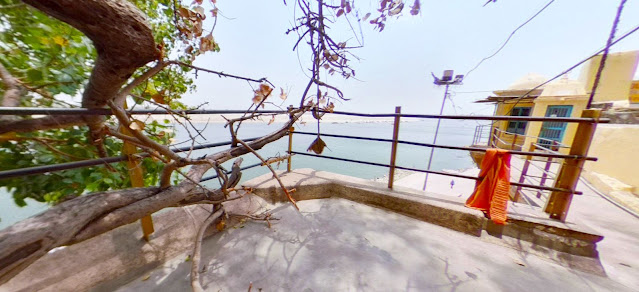 |
| View of river Ganga from the Temple |
12) YAMADITYA TEERTHA
The 12th great Surya teertha is Yamaditya. It is said one becomes free of all indebtedness to the ancestors by offering Tarpanam to Pitrs on a Mangalavara, Chaturdashi having Bharani nakshatra. It is also said a darshana of Yamaditya will keep anyone away from Yamaloka.
 |
| Yamaditya |
The above are the 12 most significant Surya teerthas in Kashi. Skandha also says there are more Sun temples like Guhyakarka installed by devotees of Surya. Just by listening to the origin of these Sun Temples of Kashi, a person does NOT fall into Naraka.
All the information on the 12 Sun Temples of Kashi are spread over 7 Adhyayas of both the Purvardha & Uttarardha bhaga of the Kashi Khanda in the Skandapuranam. I've tried to squeeze as much relevant info into this post as possible.
Skanda says by listening to these Adhyayas explaining the 12 Adityas & by narrating them to others, a person accumulates maha punya & so does the listener.
As we can see all the original Murthis have been lost to brutal islamic invasions. What remains is a mere shadow of what once were magnificent Temples. It is to the credit of the people of Kashi, especially the Brahmanas who attend & serve to these deities to have kept these timeless Temples in the civilizational memory of our people alive.
Let Suryanarayana bless us all with strength & might to reclaim & restore all his Temples at Kashi & all of Bharat.
Reference
Skandapuranam by Nag Publishers.
http://pawanpath.up.gov.in/
